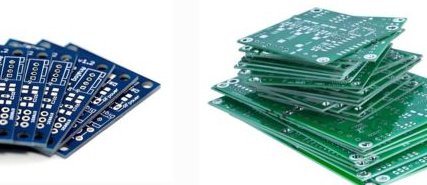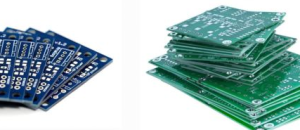
When you first open a development board or examine a piece of electronics, one of the most striking features is the color of the printed circuit board (PCB). Traditionally, PCBs have been green for decades, largely because of the solder mask material used and manufacturing conventions. However, blue PCBs have become increasingly common in maker spaces, hobbyist kits, and even professional products. This leads to the central question for many builders and designers: Are Blue PCBs Better Than Green PCBs for Your Projects?
This question isn’t purely aesthetic. PCB color often signals differences in material properties, manufacturing processes, or simply branding decisions. Understanding what these colors imply helps makers make informed choices. In this article, we’ll go deep into the technical and practical aspects of PCB color selection. We’ll also draw on our own hands-on experience with both blue and green PCBs to evaluate their impact on your project’s success.

Are Blue PCBs Better Than Green PCBs
When analyzing Are Blue PCBs Better Than Green PCBs, it’s essential to separate solder mask aesthetics from actual substrate properties. Most blue and green PCBs use the same fiberglass-reinforced epoxy (FR-4) core. The difference lies mainly in the pigment of the solder mask layer.
Key factors:
Dielectric Constant (Dk): Essentially unchanged by solder mask color.
Thermal Performance: FR-4 and copper weight dominate; color pigment has negligible effect.
Solderability: Some claim green offers slightly better visual contrast for soldering, while blue may slightly obscure pads.
Inspection: Automated optical inspection (AOI) systems have been calibrated primarily for green, but modern systems adapt easily to blue.
Thus, Are Blue PCBs Better Than Green PCBs in terms of performance? Not inherently—though manufacturing familiarity may still give green PCBs a minor edge in consistency.
Price matters for every maker. Green solder mask is often the default, mass-produced option, which lowers cost per panel. Blue PCBs may carry a small premium because fewer manufacturers stock blue solder mask in large volumes.
Factors affecting cost:
Volume pricing—green is cheaper at scale.
Turnaround time—green has faster processing due to established supply chains.
Branding—some companies choose blue to differentiate their products despite higher cost.
When evaluating Are Blue PCBs Better Than Green PCBs financially, green still tends to win for tight budgets. Blue may be worthwhile if you want a distinctive look or if your manufacturer offers it at no extra charge.
This section answers the core question more directly. We’ve tested boards under similar conditions: same copper weight, same component layout, different solder mask colors. Results:
Thermal performance: Nearly identical.
Signal integrity: No measurable difference.
Durability: Determined more by manufacturing quality and materials than color.
However, visual aspects can influence assembly:
Blue PCBs sometimes provide better contrast for white silkscreen.
Green PCBs may provide better contrast for black silkscreen.
Color can affect how easily you spot solder bridges or flux residues.
Thus, Are Blue PCBs Better Than Green PCBs functionally? Only if the color aids your assembly or inspection process.
When evaluating Are Blue PCBs Better Than Green PCBs in the context of manufacturing, it’s useful to examine how each color affects the fabrication workflow. Green solder mask is the industry standard. It has been extensively tested for viscosity, curing times, adhesion, and compatibility with automated processes. Blue solder mask, while common today, entered the market later and has slightly different processing characteristics.
Solder Mask Application
Green solder mask resins often cure more predictably under standard UV exposure.
Blue solder masks may require slightly different energy levels or curing times, depending on the brand.
Inspection and AOI Systems
Automated Optical Inspection (AOI) systems were originally calibrated for green. Although they now handle blue, there may still be subtle differences in contrast detection.
Human inspectors may find green easier for spotting small solder defects because it’s so familiar.
Screen Printing and Silkscreen Contrast
White silkscreen on blue PCBs can pop visually, offering a premium look.
Black silkscreen on green PCBs is the traditional pairing, known for readability.
Thus, in the manufacturing environment, Are Blue PCBs Better Than Green PCBs mainly comes down to your fabricator’s experience with each solder mask color.
In global supply chains, green solder mask is produced in larger volumes and stored widely. Blue solder mask materials are available but may be in shorter supply in some regions. This can influence lead times.
Lead Time Differences
Green PCBs typically have the fastest turnaround times.
Blue PCBs might add one to two days, depending on stock.
Cost of Pigments
Blue pigments may be slightly more expensive due to lower production volumes.
Many PCB houses now absorb this cost for small runs but charge for mass production.
Therefore, Are Blue PCBs Better Than Green PCBs from a supply standpoint? Green still holds the advantage in pure availability, but blue is catching up as more customers request it.
With sustainability becoming a design requirement, many makers ask if solder mask color affects environmental impact. The pigments themselves are usually inert and form a negligible portion of the total PCB. The bigger environmental footprint comes from fiberglass, epoxy, copper plating, and waste etchants.
Recycling and Disposal
Both blue and green PCBs are processed similarly in recycling streams.
The color pigment does not materially affect recyclability.
Manufacturing Waste
Waste streams from solder mask application are managed with similar protocols regardless of color.
In short, Are Blue PCBs Better Than Green PCBs environmentally? Not really—what matters most is your manufacturer’s waste treatment policies, not solder mask color.
Testing is an overlooked but vital part of PCB development. When asking Are Blue PCBs Better Than Green PCBs, consider how color impacts your ability to perform quality checks.
Continuity Testing
Color does not affect multimeter or continuity testing directly. However, pad visibility can speed up probe placement.
Thermal Imaging
When using IR cameras to detect hot spots, the solder mask color has minimal impact because the emissivity is similar. What matters is consistent lighting and calibration.
Optical Inspection
Under magnification, the differences become aesthetic only. Modern microscopes with LED lighting render both blue and green masks clearly.
Thus, Are Blue PCBs Better Than Green PCBs for testing? No measurable performance difference, but human factors (like ease of spotting a bridge or a missed joint) still matter.
Durability is determined by copper adhesion, laminate Tg, via quality, and plating thickness. Still, some subtle differences may appear over long exposure:
Blue solder mask may fade differently under prolonged UV light, but this does not affect performance.
Green PCBs are so widely tested over decades that their long-term reliability data is more robust.
If your project will be exposed to sunlight or extreme conditions, it’s wise to verify with your manufacturer’s datasheet rather than relying solely on color tradition.
Thus, Are Blue PCBs Better Than Green PCBs for longevity? Functionally equal; data favors green only because of its longer historical track record.
From a manufacturing perspective, green PCBs benefit from decades of process optimization. The supply chain for green solder mask materials is mature, making it easier to source reliable batches at consistent quality levels. This often translates to fewer production defects, faster lead times, and lower costs—particularly for small-batch runs.
Blue PCBs, while increasingly common, can sometimes be slightly more expensive or have longer turnaround times depending on the manufacturer’s equipment and stock. For makers with tight project timelines, the trade-off between aesthetics and logistics can heavily influence the choice. In these scenarios, it’s wise to communicate with your PCB vendor early in the design cycle to understand their current lead times and any cost implications associated with blue solder masks.
Ultimately, the question “Are Blue PCBs Better Than Green PCBs?” does not have a one-size-fits-all answer. For many makers, green PCBs remain the practical choice for their excellent cost efficiency, availability, and well-understood manufacturing process. Blue PCBs, however, offer unique branding opportunities, improved silkscreen contrast, and a premium feel that can elevate a product in the eyes of backers or customers.
From a purely technical standpoint, both colors perform almost identically in terms of electrical, thermal, and mechanical properties. Your decision should hinge on project priorities—budget, lead time, branding, and your chosen manufacturer’s capabilities.
Having examined detailed introductions, comparisons, and functional analyses, it becomes clear that the “best” choice is contextual. By working with a capable manufacturer like JM PCB, you can confidently experiment with both green and blue boards, knowing you’ll receive consistent quality and support.
The maker’s dilemma, therefore, is less about absolute performance and more about balancing aesthetic goals with practical realities. As PCB technology and the maker ecosystem evolve, this balance will tilt even further toward creative freedom—allowing every designer to choose the color that best expresses their project’s identity without compromising on reliability or performance.
Blue solder masks provide a visually distinctive appearance that can make your project stand out. They also sometimes improve contrast for white silkscreen legends, enhancing readability. However, because blue solder masks are not as widely produced as green, lead times may be longer and costs slightly higher. In most cases, electrical performance remains the same regardless of solder mask color.
Green PCBs are generally cheaper, more widely available, and easier to inspect visually under normal lab lighting. The solder mask chemistry for green PCBs has been optimized for decades, offering excellent process stability and fewer manufacturing defects. This makes green PCBs a practical choice for early-stage prototypes where cost and turnaround time matter most.
No, solder mask color itself does not significantly affect either thermal or electrical conductivity. The copper traces and dielectric material dominate these properties. What can matter is the solder mask thickness and its adhesion quality—but these parameters are independent of color. Therefore, you can safely choose blue or green PCBs based on aesthetic or logistical considerations without worrying about conductivity changes.
Makers often base their decision on perceived value, branding, and lead time. Green PCBs are faster and cheaper for limited runs, especially when prototyping. Blue PCBs, on the other hand, can elevate a product’s look for crowdfunding campaigns, early reviews, or public demonstrations. Weigh the importance of each factor against your project goals.
Most PCB houses apply solder mask only to the outer layers. Inner layers are typically copper and prepreg without mask color. You can, however, request different solder mask colors on different production runs to test which works better for your needs.
Connect to a Jerico Multilayer PCB engineer to support your project!
Request A Quote